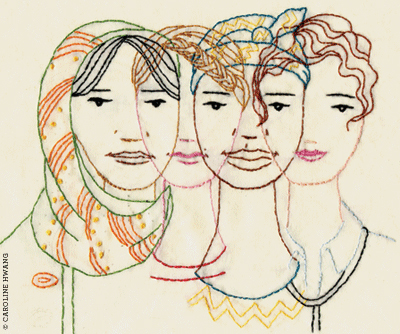
What do several hundred health-obsessed nurses eat for breakfast? On an unseasonably warm Thursday morning in April, they had bowls of fresh-cut fruit, yogurt with granola, scones, bagels, and plenty of coffee. They were gearing up for a long day of lectures and events, after all—the second in a three-day conference titled Cities and Women’s Health: Global Perspectives. “We should give thanks for the delicious food we have [this morning],” Eugenie Birch, co-director of Penn’s Institute for Urban Research (IUR) and a member of the conference’s advisory board, said to the group assembled in the Annenberg Center’s Zellerbach Theater. “It is so healthy!”
It’s fair to say health was the word of the week at Penn, where conference lectures and discussions ranged from the broad (“Women’s Health and Human Rights in the 21st Century”) to the specific (“Urbanization and Women’s Cardiovascular Health: Friend or Foe”). As for the women part of the equation, “If you think globally, women and girls are more at risk [for health issues] and the challenges are so much greater,” said Marjorie Muecke, assistant dean for global health affairs in the School of Nursing. “Safety, violence, food security, access to health services, maternal death: these are worldwide issues for women.”
The conference was a particularly fitting one for the School of Nursing to host, as it combined the themes of its 2005 conference on global issues in women’s health and its 2007 conference on urban women’s health in America. The resulting focus on the health of urban women across the globe was not only a logical next step, but also a necessary one, according to Muecke. “Urbanization is taking place around the world at a very rapid pace,” she said. “We’re looking toward the future, and we want to be the leaders, helping to create a tidal wave of scholarly interest in arenas that deal with girls’ and women’s health in cities around the world.”
In all, 32 countries were represented, along with almost as many disciplines: urban planning and architecture, anthropology and sociology, education and psychology, health policy, law and, of course, medicine.
Energized by their healthy breakfasts (and scones, for the indulgent), attendees first heard from Julio Frenk, dean of Harvard University’s School of Public Health and Mexico’s former minister of health. (In 2003, he helped introduce seguro popular—a national healthcare program for Mexico.) Frenk noted that health “offers a window through which we can understand the most pressing challenges facing women in our global urban society.”
Following Frenk’s speech, Sheela Patel, founder and director of the Society for the Promotion of Area Resource Centers, discussed some of the challenges Indian women face, particularly those who live in slums—a popular topic throughout the conference. “The ratio of men to women is beginning to really widen,” she said, “and according to recent data, there are 14 million Indian women ‘missing,’ either due to abortions of female fetuses, infanticide, children dying of malnutrition … [or] women who commit suicide due to harassment and violence.”
Patel said that in order to help women at risk for those and other health issues, healthcare workers must first understand their situations. “I still see health workers talking to poor women who have no access to clean water about hygiene and washing hands,” she said. “I hear about women being trained in providing nutritious food to their children when the whole family doesn’t even earn half a minimum wage.”
Indeed, it was clear throughout the conference that addressing urban women’s health means different things in different places. For instance, a presenter from the School of Medicine discussed student designs for neighborhood fitness parks as a way to combat obesity, but just after that, a presenter from Uganda discussed the health issues facing women in the city of Kampala: malaria, typhoid, and lack of access to water and sewage systems.
The contrast wasn’t lost on Penn IUR’s Birch. “I think the combination of papers today is illustrative of the theme that we started off the conference with,” she said. “[My] presentation will be talking about an exercise that took place in New York City in an attempt to create an understanding of what it is to design places that might be ‘healthy’—and the definition of ‘healthy’ in a city like New York is a very different definition than you would find in a city like Kampala.”
Global contrasts stood out as scholars from around the world shared their research. A single hour-and-a-half afternoon session included presentations by scholars from South Africa, Israel, Bangladesh, and Philadelphia. In the latter, Penn Nursing’s Loretta Sweet Jemmott GNu’82 Gr’87, director of the Center for Health Disparities Research, discussed the 20-minute-long HIV/STD risk-reduction program she developed for inner-city African-American women. The program helps young women build skills to reduce risk behaviors and prevent STDs—for instance, using condoms correctly and negotiating condom use with partners—and is especially important right now, she said, as AIDS cases are rising among women in their 20s, and HIV cases among 13- to 24-year-olds. Her program has done well enough reducing risk behaviors among young African-American women in Philadelphia and Baltimore that it is currently being rolled out across the country.
Other presenters discussed to whom first-degree relatives of breast-cancer patients turn for support and information (doctors more than nurses, as it turns out); the number of women utilizing maternal health services in the urban slums of Bangladesh (not nearly enough); and domestic violence against women in Brazil. By offering such a wide variety of women’s-health topics, “We were hoping to have [attendees] look at this issue and say, ‘Wow, we haven’t been paying any attention to this. We do need more research. How does my expertise relate to this so I can help?’” Muecke said.
The organizers also launched the Urban Women’s Health Collaborative, a Web-based “open learning commons” that features a variety of blogs and videos, a reference library, and discussion forums. The idea was to create a permanent space for social networking, engaging both scholars and members of the public, Muecke said. To help in the process, Penn Nursing received a Rockefeller grant to recruit 12 mid-career leaders from around the world who are currently adding content to the site.
The School of Nursing also saw the conference as an opportunity to highlight the University’s commitment to improving the health of women, children, and families in urban communities. “It’s a Penn-wide interest, but it’s led by the School of Nursing,” Muecke said, noting that leaders from the Department of City and Regional Planning and the women’s-studies program, among others, have also shown interest in the initiative. “We really see this as an emerging field, and we’re trying to take the lead in making it happen sooner. To do that, it has to be very interdisciplinary and cross-sectional. We need NGOs, policymakers, people from all across campus.”
In her conference-opening speech, President Amy Gutmann expressed a similar call for action. “To improve the opportunities and life choices of urban women, we need an effective coalition of researchers, clinicians, educators, and community advocates to identify the most effective policies and then to push for significant policy changes in the world’s cities: more employment opportunities, equal pay for equal work, vastly improved prenatal and postnatal care, childcare for working women, and high standards of education for all children,” she said.
—Molly Petrilla C’06




